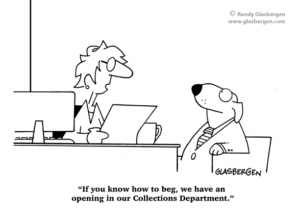Today we have a very special article from Julie Elster, founder of Just Tell Julie, a service that helps you turn your overdue invoices & failed payments into customer services opportunities.
Julie spent over 10 years in Corporate America working with accounts receivable and she certainly knows her way around debt collection tactics. Today she is an accounts receivable virtual assistant and helps make getting invoices paid painless for freelancers. Through her Thermonuclear Niceness, Julie quickly turns mildly overdue invoices into customer service opportunities. In this article, Julie teaches us how to get paid!! Sound good? — take it away Julie!
The End of Overdue Invoices: Are you using these two methods?
Owning your own business has some truly amazing benefits. You can make your own hours. You can take on the projects that you want, and turn down the ones you don’t. You can work on your terms, and do it your way.
The downside? Sending an invoice, and hitting the refresh button on your email over and over again waiting for the notification that your client has paid – like your inbox is an awful freelancing slot machine that mostly dispenses spam. Without the other regular recurring revenue, overdue invoices are especially painful for small teams and solopreneurs.
There is a surprisingly easy and simple solution to keep the late and non-payers at bay. It’s so remarkably simple I’m shocked not everyone does it.
Ready? Here we go:
To avoid late and non-payers every single time, collect payment upfront. Collect payment before work starts. If the client doesn’t want to pay, the work doesn’t begin. It really is as easy as that.
Ok, maybe I’m oversimplifying it just a little bit, but it really can be done. I have worked in accounts receivable for years, and make a living reaching out to clients who haven’t paid their invoices. The #1 thing I tell my clients is to reconsider their process when it comes to collecting payment from clients to prevent the problem before it starts. The majority of clients I work with charge hourly rates. When a client approaches them to work they collect a small deposit upfront. When the work is complete they send an invoice based on the number of hours the project took to complete. Then they wait, hoping the invoice is paid in a timely manner. Does that sound familiar?
Outline Expectations:
The first step in collecting upfront payment is to make your expectations clear to your clients before the work even begins. Try this with your next new client. When you are approached by your next client set up your payment expectations right off the bat. Qualify your client to make sure that they are a great fit for you and your business.
This means making sure they are on board with your work expectations, your business needs, and your payment terms. When you are laying out the needs and goals of the project, payment expectations should be included in that discussion. Keeping the conversation open and honest when concerning payment is the easiest way to avoid disputes down the line. Consider asking prospective clients, “can you presently afford to budget me as an investment in your business?”
When having these discussions with my clients, I am often met with push-back. I hear about how their clients aren’t able to pay upfront. Or how they only pay by check. Or they have to get a dozen approvals before they can make any payments. Or they are concerned that I won’t deliver if they pay me upfront. I hear every excuse possible because it’s easier to assume upfront payments can’t be done, so let’s back up a little bit. How do we approach payment upfront when all we have ever done is work, invoice, and wait for payment.

Setting up your expectations before you start to work is beneficial for several reasons. If your client understands how you work and what you need from them, you’ll avoid confrontation down the line. You’ll, in turn, have an understanding of their expectations of you. All of this helps you to find the clients you WANT to work with and avoid the potential nightmare clients. Perhaps most importantly, though, is knowing that when you set up expectations regarding payment, they won’t be able to flake out on payments, or push scope creep when you send your invoice out.
Fixed prices and transparency:
Once your expectations are clear to the client, it’s time to talk about rates. Instead of charging hourly rates, try quoting your client fixed rate prices. You are a professional and know the value of your work. Be upfront about your rates, and quote your client prices based on the entire project discussed. Transparency on your pricing will avoid issues down the line when it comes to rates and scope. And if the client knows the project will cost a specific amount, requesting upfront payment will be that much easier.
This process is going to be way easier with a brand new client. If you are trying to move existing clients who are used to paying after you deliver, this may be a little tricky. If a current client complains, which they might, you could offer them a choice. Tell them “the 100% upfront payment is actually discounted 10% as a thank you for your advance payment. I am happy to split up your payment into two 50/50 payments. However, you will lose that 10% discount.” Everyone loves a discount. So hopefully they jump on that and pay upfront. If not, you were just able to tack on 10%. Bill them for the 50% payment. Again, don’t start ANY work until they pay that invoice. Let them know that you’ll be stopping work at X point in the project, and billing them for the balance.
If you are doing that, I would make sure to send that second invoice with the balance before you get to the stopping point. If you know you will be finishing up with this part of the project next week, send that invoice out immediately. The idea here is that you don’t want to be working if you haven’t yet been paid. You also don’t want to have to halt work completely while you are waiting for them to pay that invoice. You want to give your client a little time to receive and pay that invoice, so I would let the client know – “Hey! The project is going great. I should be getting to point X that we discussed by next week. Here is the invoice for the balance. I’m excited to get rocking on the second half of this for you.” You are still getting paid BEFORE doing the work, and you will avoid stopping work while waiting for that payment to come through. So it IS possible to break up the payments.
Changing the way you look at your billing practices can end past due invoices. Qualifying your clients not only helps you find clients you WANT to work with, but it makes your payment expectations clear before you even begin working. Charging upfront fixed prices ensures your rates are clear and avoids non-payment due to rate conflicts.
In short, ask for payment upfront. Every time. These simple changes ensure you are working with clients you want to work with. This will be the end to unpaid invoices.